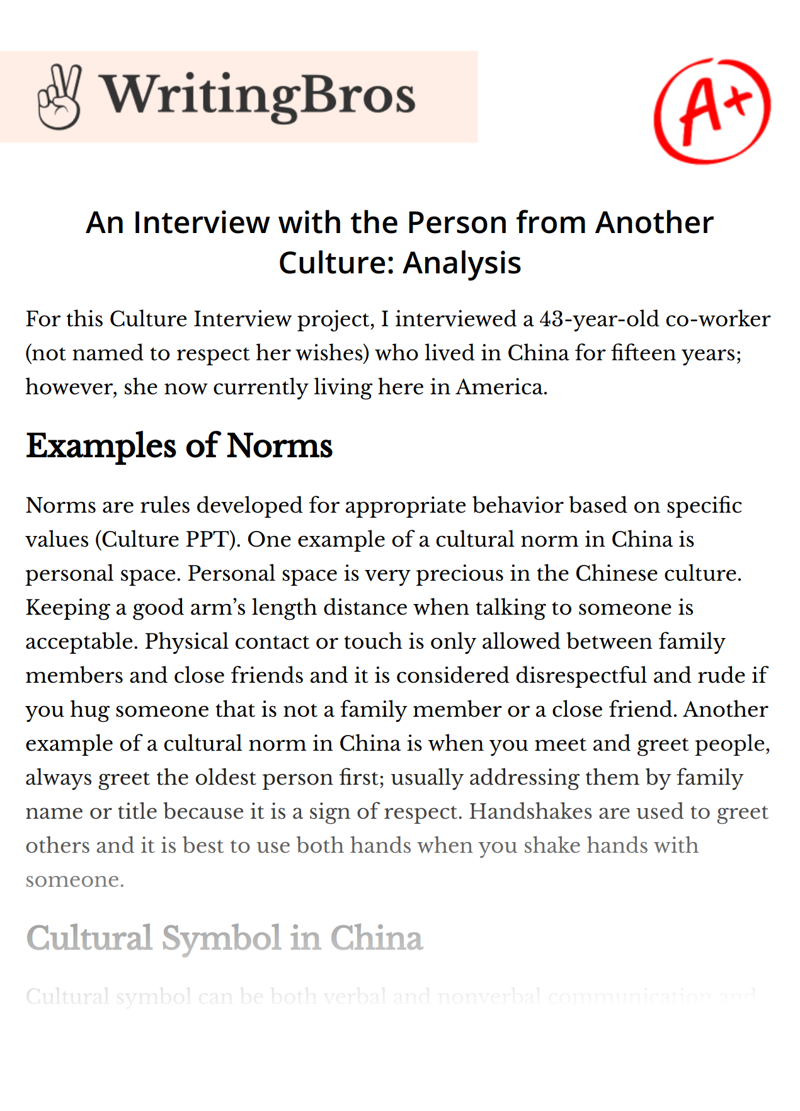An Interview with the Person from Another Culture: Analysis

Table of contents
For this Culture Interview project, I interviewed a 43-year-old co-worker (not named to respect her wishes) who lived in China for fifteen years; however, she now currently living here in America.
Examples of Norms
Norms are rules developed for appropriate behavior based on specific values (Culture PPT). One example of a cultural norm in China is personal space. Personal space is very precious in the Chinese culture. Keeping a good arm’s length distance when talking to someone is acceptable. Physical contact or touch is only allowed between family members and close friends and it is considered disrespectful and rude if you hug someone that is not a family member or a close friend. Another example of a cultural norm in China is when you meet and greet people, always greet the oldest person first; usually addressing them by family name or title because it is a sign of respect. Handshakes are used to greet others and it is best to use both hands when you shake hands with someone.
Cultural Symbol in China
Cultural symbol can be both verbal and nonverbal communication and physical objects that are important in any culture and are symbols that represent certain meaning or things (Macionis, 2016). One example of a cultural symbol in the Chinese culture is color symbolism. In China, specific colors have certain meanings like red symbolizes celebration, happiness, power, and good luck, yellow represent power or royalty, black is associated with evil, sadness, and destruction, while white stands for purity and sometimes associated with death because it is the color worn at funerals.
Common Folkways of Chinese culture
Common folkways are informal norms or behaviors based on social expectation or traditions (Culture PPT). A common folkway example in China is how you present your table and dining manners. When you are invited to someone’s house for dinner, wait to be told where you will sit. The elderly and the guest of honor is usually seated first. Another polite table manner is serving food to those around you first before you serve yourself.
Example of Cultural Shock
Culture shock is when a person encounters a culture foreign to his or her own and has an emotional response to the differences between the cultures (Culture PPT). An example of a culture shock for my interviewee is how Americans treat seniors and elders. In China, elders are treated with the most respect and live with their families for many generations until their death. It was a cultural shock for my co-worker to see Americans put their grandparents (when they are old) in nursing homes.
Example of Ethnocentrism
Ethnocentrism is when a person uses his or her own culture to judge another culture (Culture PPT). An example of ethnocentrism in the Chinese culture is using traditional chopsticks with every meal. Chinese people find using forks, spoons, and knives unnecessary in the American culture but have learn to appreciate that this is the American way/style of eating food.
Example of Culture Taboo
Culture taboo is an act that is socially unacceptable (Culture PPT). In China it is considered a cultural taboo when you write someone’s name in the color red. If you write someone’s name in red, it is portrayed as bad news of someone passing away. The color red is only used for writing a criminal’s name and only for the names on tombstones. Another cultural taboo is don’t whistle at night. People in China believe that whistling at night will attract wandering spirits and ghosts to follow you and take the person who whistles away.
Conclusion
I had fun learning about my co-worker’s cultural background. I find it interesting that some of her cultural values and folkways are similar to my own Hmong culture. After interviewing her, I now have a deeper understanding and appreciation for her Chinese culture. It was nice to get to know her outside of work too. I really enjoyed this cultural assignment and would definitely interview someone else again.
Cite this Essay
To export a reference to this article please select a referencing style below

